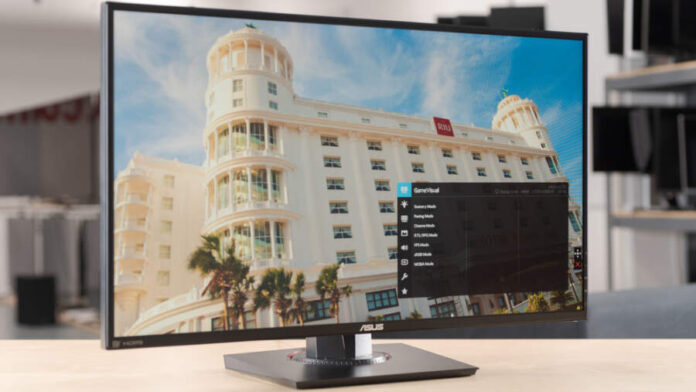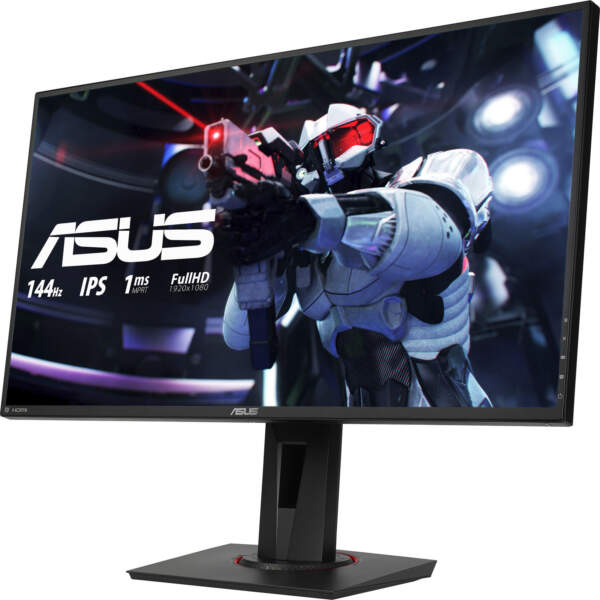The Asus VG279Q is a high-refresh 1080p panel with IPS technology and great viewing angles and colour quality. This recent addition to a series of gaming monitors that leads the market is especially exciting due to the combination of qualities that many have wanted. In this article we will be talking about its specification, features and drawbacks.
Asus VG279Q Specification
- Screen Size: 27 Inches
- Resolution: 1920 x 1080 FHD
- Aspect Ratio: 16:9
- Panel Technology: In-Plane Switching (IPS)
- Refresh Rate: 144Hz
- Response Time: 3ms
- Contrast Ratio: 1000:1 (Static)
- Brightness: 400 cd/m²
- Connectivity: HDMI 1.4 x 1, DisplayPort 1.2 x 1, DVI-DL x 1, 3.5mm Jack
- Dimensions (W x H x D): 24.4” x 14.8” x 8.3”
- Weight: 12.35 lbs.
Image Quality
The Asus VG279Q has a 27-inch IPS screen with a 1920 x 1080 resolution, a refresh rate of 144Hz, and a response time of 3ms. It’s worth noting that this model has a 1ms MPRT feature to improve pixel transition and reduce blurring. The display also features strong 400 nits of brightness and a 1000:1 contrast ratio.
The first thing you will notice about this display is its low pixel density, which softens images. Lines and edges appear less sharp than on a 24-inch model, yet this choice has its advantages. Some E-Sports players favour the looser pixel ratio since it enlarges distant things like opponents’ heads or limbs, allowing them to see and trace.
It provides excellent colour reproduction using the Racing colour filter, spanning slightly more than 99% of the sRGB range. The average accuracy is 1.80, which is good for a gaming display and eliminates the need for complex calibration. The colour temperature of the screen is very near to the optimal 6500 K value, thus it appears well balanced.
Other features include regular ASUS gaming display bells and whistles like GamePlus (crosshairs, timers, and an FPS monitor), Game Visual (FPS, RTS, Racing, RPG, MOBA, sRGB, Cinema, Scenery picture presets), and Shadow Boost for greater visibility of objects in dark sections of games.
Performance and Gaming
This makes the Asus VG279Q appealing for gaming, but it might also serve as a basic editing monitor. TN and VA-based alternatives typically struggle in this area, making them less desirable options for many users.
The backlight is quite powerful, with a maximum brightness of 460cd/m2. Sadly, the display does not significantly improve the display’s contrast. That rating is still good, but current models can get up to 1200:1 for more range.
These numbers cause blacks to appear yellowish, and some dark colours to appear washed out, particularly in dark titles like the Division 2. Well-lit games, such as Apex Legends, are less impacted, but these flaws might become visible and irritating in some cases.
The panel uniformity isn’t as great as we had hoped, but that’s to be assumed from an IPS panel. There are minor leaks on the screen’s corners that affect black uniformity, but they aren’t evident during in-game scenes. Because no two devices are created equal, this feature can change from unit to unit.
We don’t expect most people will use its overdrive functions because it handles motion so well. Blurs and image stability are not difficulties with the display’s performance, which is excellent given that it is an IPS type. If you have particularly sensitive eyes and detect these faults in games like CSGO, you can use the 1ms MPRT option to further clear the image.
The Asus is a FreeSync gaming monitor that supports a functional range of 40Hz to 144Hz, making it ideal for AMD GPU users. It’s also recognised and verified as G-Sync capable, allowing the vast majority of Nvidia customers to partake. When using this, input lag is restricted to 10ms, thus there are no delays or “de-synced” instances.
Design and Build
The Asus maintains the brand’s acclaimed gaming line’s general look, which is basic yet appealing to today’s gamers. The matte black body provides a great, easy-to-clean finish that will not stain or smudge. The monitor does not have any bezels, but there are 10mm border on three sides due to the multi stage design.
Even though it is priced lower than the ROG Swift displays, it has great build quality and design. Because of the brand’s superior QC/QA procedure, the chassis’ corners are clean cut and even throughout. We also didn’t observe any bending or cracking on the monitor when changing the display, indicating that it should be able to survive the demands of daily use with ease.
One of the things we like about Asus gaming displays is the updated control layout, which makes it easier to use the OSD. The Asus VG279Q lacks a remote however it does offer a multi-directional joystick with hotkeys for convenience. Navigating through built-in features like GamePlus is as simple as pea and less complex than most competitors.
It also includes a fully adjustable stand with height, tilt, rotation, and pivot settings. Because the gear used is similar to that found on versions. It is extremely reliable and does not require replacement. However, because this part hides the chassis 100 x 100 pattern, you can still use a VESA display arm.
The base stand takes up little space, but it provides good stability for the larger-than-average display. The rotating joint has a red ring, but it does not light up. The entire gadget matches the latter, except the ROG swag, such as badges and features like LED rings, are missing in this generation.
Connectivity
The Asus VG279Q’s I/O panel offers everything you’ll ever need to use the device as an all-in-one screen for your devices. The layout features DisplayPort 1.2, HDMI 1.4, and DVI-DL ports, but no USB connectors for peripherals. There are two 2-watt speakers however the sound quality will push you to a separate set of headphones.
Conclusion
Because of its accurate IPS panel, the Asus VG279Q is a great gaming display for its price. Asus responded with a respectable alternative because a 1080p 144Hz IPS panel has been on many wish lists. This model outperforms its higher-tiered brothers, assuring it will perform well in the market.
The one obvious flaw in this monitor is the limits of its IPS display, such as the low dynamic range. In certain cases, the screen appears yellowish or slightly washed out when compared to the TN and VA models we’ve tested. Aside from that, the screen is a fantastic pick if you’re looking for a 1080p gaming model with outstanding viewing angles.
Read Also : 120Hz Monitor: Does High Refresh Rate Display Matter and Buying Guide




































































